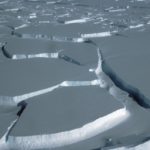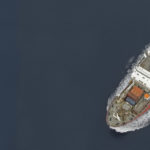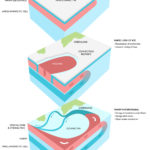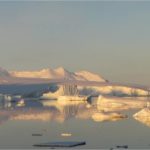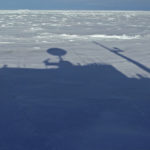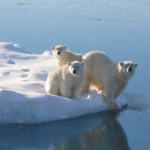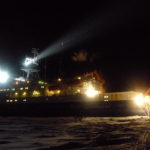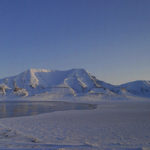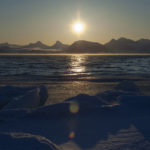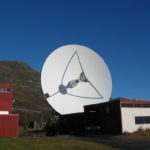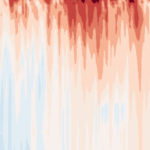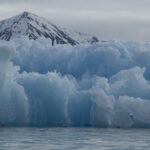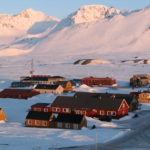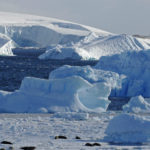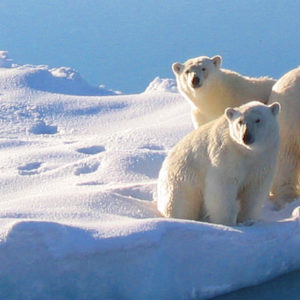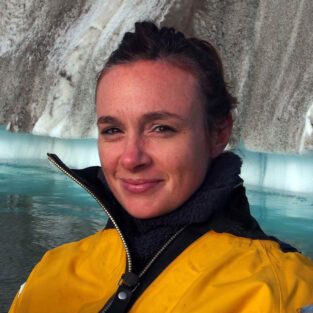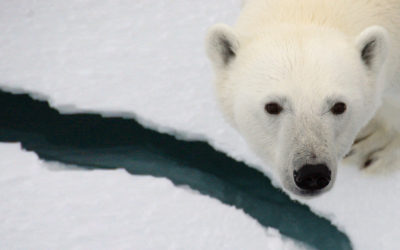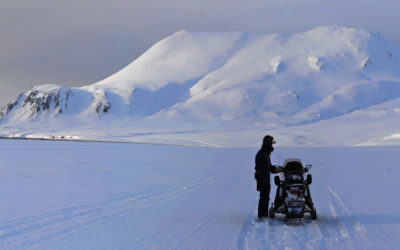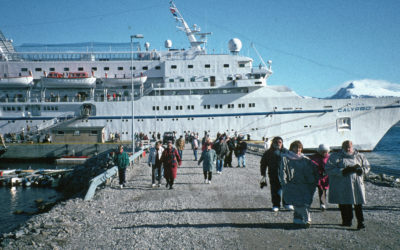BAS-Arctic Working Group
Working Group purpose
The Arctic Working Group is a group of more than 60 BAS scientists and operations staff who are currently working in the Arctic or have aspirations to work there. The AWG was started in 2018 to bring together researchers in different fields to share their experiences of Arctic research, to enable new collaborations, and to maximise the potential output of this group by coordinating efforts and knowledge regarding Arctic projects, funding calls and logistics.

Terms of Reference
Content coming soon
Our priorities
Content coming soon
Map of Arctic Working Group projects
Arctic marine geophysics
This research focuses on investigating the glacial histories of Arctic ice sheets and ice caps using the marine geological record preserved on continental margins. By reconstructing past ice sheets, their …SDOO
Abrupt warming episodes punctuate Greenland ice core records throughout the last glacial period. These events were first identified in two Greenland stable water isotope records (Dansgaard et al., 1993), and …Climate and Ice during the Last Interglacial
During the Last Interglacial (129-116 thousand years ago, ka) CO2 and global temperature were both higher than they were before human industrialisation. By examining Last Interglacial climate, we thus gain …TEA-COSI
TEA_COSI assesses Arctic Sea-ice which has an important impact on currents and ocean circulations around the globeUKESM-BAS
Reliable projections of the Earth’s climate are at the heart of scientific support for international efforts to address global change. There is increasing recognition that reliable projections require that physical …ESA IAP ArcticSat project
Situational awareness in the ArcticICE-ARC
physicists, chemists, biologists, economists, and sociologists from 21 institutes in 11 countries across Europe assess the rapid retreat and collapse of Arctic sea-ice coverSIOS
Svalbard Integrated Earth Observing System (SIOS) is an international infrastructure project. There are 26 partners from Europe and Asia involved. The essential objective is to establish better coordinated services for …SEANA
Global shipping is undergoing significant changes. In January 2020 the maximum sulphur emission by ships in international waters will reduce from 3.5% to 0.5% by mass, as a result of …Data As Art
DATA AS ART is an ongoing science & art project in development at NERC’s British Antarctic Survey (BAS). It visualises science data (in its widest definition), to create stunning and …EISCAT Science Support
The UK EISCAT support group (UKESG) is a collaboration between the British Antarctic Survey and the Rutherford Appleton Laboratory, funded via the National Centre for Atmospheric Science (NCAS) EISCAT, the …Iceland Greenland seas Project
PI: Ian Renfrew (University of East Anglia) CO-I’s: Tom Bracegirdle, Tom Lachlan-Cope, Alexandra Weiss PDRA’s: Andrew Elvidge (University of East Anglia), James Pope NERC Grant: NE/N009924/1 Project Partners: Robert Pickart …ACSIS
Major changes are occurring across the North Atlantic climate system: in the ocean and atmosphere temperatures and circulation, in sea ice thickness and extent, and in key atmospheric constituents such …Increasing ship traffic in Inuit Nunangat
17 August, 2023
Researchers from British Antarctic Survey are heading to the Canadian Arctic this week to learn more about the impacts of increasing ship traffic in Inuit Nunangat. In recent years, climate …
Poet Laureate visits UK Arctic Research Station
14 July, 2023
The UK Poet Laureate Simon Armitage CBE has travelled to the UK Arctic Research Station, where he will create new works inspired by the visit. While hosted at the UK …
Britain’s Arctic Research Station celebrates 30 years of science and monitoring climate change
28 September, 2021
The Arctic Station in Ny-Ålesund, Svalbard in Norway, the UK’s permanent Arctic research facility, celebrates its 30 years anniversary this week (Tuesday 28 September) as it continues to undertake critical …
BAS celebrates International Day of Women and Girls in Science
11 February, 2022 by Melody Clark
Today, 11 February, is International Day of Women and Girls in Science, a global initiative led by UNESCO and UN-Women. To celebrate, we have asked some of our female staff …
The deglacial history of 79N glacier and the Northeast Greenland Ice Stream
15 July, 2024 by James Smith
The Northeast Greenland Ice Stream (NEGIS) is the main artery for ice discharge from the northeast sector of the Greenland Ice Sheet (GrIS) to the North Atlantic. Understanding the past,…Read more on The deglacial history of 79N glacier and the Northeast Greenland Ice Stream
Ancient diversification in extreme environments: Exploring the historical biogeography of the Antarctic winged midge Parochlus steinenii (Diptera: Chironomidae)
11 July, 2024 by Chester Sands, Felipe Simoes, Peter Convey
The terrestrial fauna of Antarctica consists of a limited number of species, notably insects, small crustaceans and other micro-invertebrates. Over long periods of evolutionary isolation, these organisms have developed varying…Improved Energy Resolution Measurements of Electron Precipitation Observed During an IPDP‐Type EMIC Event
9 July, 2024 by Aaron Hendry, Alexander Lozinski, Mark Clilverd
High energy resolution DEMETER satellite observations from the Instrument for the Detection of Particle (IDP) are analyzed during an electromagnetic ion cyclotron (EMIC)-induced electron precipitation event. Analysis of an Interval…Ice sheet–free West Antarctica during peak early Oligocene glaciation
4 July, 2024 by Claus-Dieter Hillenbrand, James Smith, Robert Larter
One of Earth’s most fundamental climate shifts – the greenhouse-icehouse transition 34 Ma ago – initiated Antarctic ice-sheet build-up, influencing global climate until today. However, the extent of the ice…Read more on Ice sheet–free West Antarctica during peak early Oligocene glaciation
Molecular phylogenetics of the superfamily Stromboidea (Caenogastropoda): New insights from increased taxon sampling
4 July, 2024 by Alistair Crame
The superfamily Stromboidea is a clade of morphologically distinctive gastropods which include the iconic Strombidae, or ‘true conchs’. In this study, we present the most taxonomically extensive phylogeny of the…Multi‐Frequency SuperDARN Interferometer Calibration [Method]
3 July, 2024 by Gareth Chisham
The ground-based, high-frequency radars of the Super Dual Auroral Radar Network (SuperDARN) observe backscatter from ionospheric field-aligned plasma irregularities and features on the Earth's surface out to ranges of several…Read more on Multi‐Frequency SuperDARN Interferometer Calibration [Method]
Fungal and fungal-like diversity present in ornithogenically influenced maritime Antarctic soils assessed using metabarcoding
2 July, 2024 by Peter Convey
We assessed soil fungal and fungal-like diversity using metabarcoding in ornithogenically influenced soils around nests of the bird species Phalacrocorax atriceps, Macronectes giganteus, Pygoscelis antarcticus, and Pygoscelis adelie on the…Network analyses on photographic surveys reveal that invertebrate predators do not structure epibenthos in the deep (~2000m) rocky Powell Basin, Weddell Sea, Antarctica
2 July, 2024 by Huw Griffiths, Rowan Whittle, Tasnuva Khan
Predator-prey interactions in marine ecosystems control population sizes, maintain species richness, and provide intermediate disturbance. Such ecosystem structuring interactions may be rare in Antarctic epibenthic communities, which are unique among…Antarctica is less isolated with increasing depth – evidence from pycnogonids
1 July, 2024 by Huw Griffiths
No other group of animals typifies the uniqueness of Antarctic life more than Pycnogonida (sea spiders), with 20% of all known species found in the Southern Ocean, and 64% of…Read more on Antarctica is less isolated with increasing depth – evidence from pycnogonids
Antarctic Waters
1 July, 2024 by Claire Allen, Dieter Tetzner
Here, we summarize the diatom research topics and applications that have the broadest relevance and importance for Antarctic studies. From the Southern Ocean we focus on biogeography, sea surface temperature…The Impact of CO2 and Climate State on Whether Dansgaard–Oeschger Type Oscillations Occur in Climate Models
29 June, 2024 by Irene Malmierca Vallet, John Slattery, Louise Sime
Greenland ice core records feature Dansgaard–Oeschger (D-O) events, which are abrupt warming episodes followed by gradual cooling during ice age climate. The three climate models used in this study (CCSM4,…Occurrence of an unusual extensive ice-free feature within the pack ice of the central Weddell Sea, Antarctica
29 June, 2024 by Caroline Holmes, John Turner, Thomas Caton Harrison, Tony Phillips, Tylei Reeves-Francois
We investigate an unusual extensive ice-free feature (EIF) within the pack ice that developed in the central Weddell Sea in December 1980 on the edge of the multi-year sea ice…Detrital input sustains diatom production off a glaciated Arctic coast
28 June, 2024 by Kate Hendry
In the Arctic and subarctic oceans, the relatively low supply of silicon (compared to other nutrients) can make it limiting for the growth of diatoms, a fundamental building block of…Read more on Detrital input sustains diatom production off a glaciated Arctic coast
Measuring the impact of wharf construction on the Antarctic Benthos
24 June, 2024 by Ben Robinson, David Seaton, Kevin Hughes, Simon Morley
Shallow water Antarctic marine macroepifaunal assemblages live in one of the most naturally disturbed marine environments due to the impact of icebergs scouring the seafloor. They are, however, amongst the…Read more on Measuring the impact of wharf construction on the Antarctic Benthos
Freezing-induced acidification of sea ice brine
24 June, 2024 by Xin Yang
The acidity of sea ice and snow plays a key role in the chemistry of the cryosphere; an important example lies in the photochemical catalytic release of reactive bromine in…Read more on Freezing-induced acidification of sea ice brine
Cumberland Bay (South Georgia) glacial evolution during the Holocene
24 June, 2024 by Claire Allen, Victoria Peck
Today, South Georgia is heavily glaciated with glaciers often terminating into the ocean via steep-sided bay and U-shaped valleys. However, due to a low number of well-dated climate records from…Read more on Cumberland Bay (South Georgia) glacial evolution during the Holocene
Enzymes and biosurfactants of industrial interest produced by culturable fungi present in sediments of Boeckella Lake, Hope Bay, north‑east Antarctic Peninsula
22 June, 2024 by Peter Convey
This study characterized cultivable fungi present in sediments obtained from Boeckella Lake, Hope Bay, in the north-east of the Antarctic Peninsula, and evaluated their production of enzymes and biosurfactants of…The importance of cloud properties when assessing surface melting in an offline-coupled firn model over Ross Ice shelf, West Antarctica
21 June, 2024 by Andrew Orr, Ella Gilbert, Ruth Price, Thomas Bracegirdle, Tony Phillips
The Ross Ice Shelf, West Antarctica, experienced an extensive melt event in January 2016. We examine the representation of this event by the HIRHAM5 and MetUM high-resolution regional atmospheric models,…South Georgia marine productivity over the past 15 ka and implications for glacial evolution
18 June, 2024 by Claire Allen, Victoria Peck
The subantarctic islands of South Georgia are located in the Southern Ocean, and they may be sensitive to future climate warming. However, due to a lack of well-dated subantarctic palaeoclimate…Ground-based Remote Sensing of Aerosol, Clouds, Dynamics, and Precipitation in Antarctica – First results from the one-year COALA campaign at Neumayer Station III in 2023
14 June, 2024 by Markus Frey
Novel observations of aerosol and clouds by means of ground-based remote sensing have been performed in Antarctica over the Ekström ice shelf on the coast of Dronning Maud Land at…